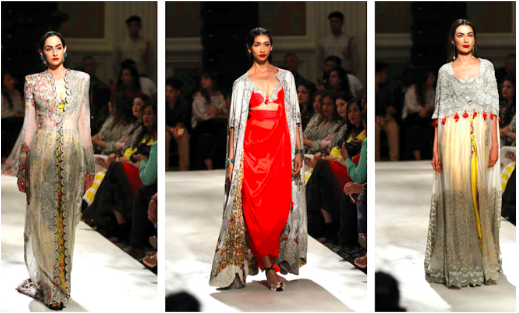Leading 10 Eastern Wear Pakistan Brands You Required to Know About
Wiki Article
Unlock the Secrets of Ageless Eastern Wear
Exploring the enigmatic realm of timeless Eastern wear digs into a world where history, creativity, and culture assemble to produce garments that transcend plain fabric and thread. The detailed tapestry of tradition interwoven with contemporary elements offers a peek into a globe where every stitch tells a tale, every theme a symbol of relevance. Introducing the keys behind these productions introduces a tapestry of heritage waiting to be untangled, welcoming one to journey via the angelic charm and mystique of Eastern fashion.History of Eastern Style
The background of Eastern style go back centuries, showing the rich cultural heritage and traditions of varied areas across Asia. Each region flaunts its one-of-a-kind styles, materials, and styles that have been influenced by variables like environment, religious beliefs, social standing, and profession routes. eastern wear pakistan. The intricate silk garments of China represent beauty and sophistication, while the vivid saris of India display a kaleidoscope of shades and patterns.In Japan, the kimono has been an icon of tradition and improvement for generations, with different designs used for numerous celebrations. The history of Eastern fashion is a tapestry of development and tradition, mixing old techniques with contemporary impacts to develop an ever-evolving and dynamic industry.
Value of Traditional Outfit
Standard clothes functions as a cultural emblem, symbolizing the values, ideas, and heritage of communities in Eastern cultures. eastern wear pakistan. These garments are not simply items of material however are symbolic depictions of the rich history and traditions passed down through generations. In Eastern cultures, standard clothes plays a substantial duty in events, events, and day-to-day live, showing the social status, regional associations, and also marriage status of individualsThe significance of traditional attire goes beyond visual appeals; it is a way for people to link with their roots and express pride in their social identity. Each garment, from the elaborate sarees of India to the moving hanboks of Korea, brings with it a story of craftsmanship, symbolism, and importance that is deeply embedded in the fabric of culture.
In addition, conventional clothing acts as an aesthetic language, connecting stories of strength, unity, and accomplishment. By using these garments, individuals not just honor their heritage however also add to the conservation and event of their cultural heritage.
Evolution of Eastern Embroideries
How have Eastern embroideries progressed in time to show altering social influences and imaginative trends? Eastern needleworks have a rich history that extends centuries and have actually constantly progressed to incorporate diverse cultural impacts and react to changing artistic patterns. The evolution of Eastern needleworks can be mapped back to ancient human beings where detailed styles were hand-stitched onto textiles using standard strategies. Throughout the years, these embroideries have actually adjusted to mirror the transforming preferences and choices of various areas and ages.
Today, Eastern embroideries remain to progress, mixing traditional craftsmanship with modern design sensibilities to produce classic items that commemorate the appeal of multiculturalism and artistic advancement.
Luxurious Fabrics in Eastern Put On
Lavish textiles play a crucial function in elevating the visual charm and high quality of Eastern wear, enhancing the total appeal and sophistication of typical garments. Eastern wear is renowned for its opulent textiles that not only mirror the region's abundant social heritage yet also indicate beauty and poise.In enhancement to silk, materials like brocade, velvet, and chiffon are also frequently included in Eastern wear. These elegant materials not only raise the visual appeal of Eastern wear however additionally ensure a sense of refinement and class that transcends time.
Incorporating Eastern Fashion Today
In modern style landscapes, the assimilation of Eastern affects offers an unified blend of social heritage and modern appearances. Developers and fashion fanatics alike are embracing the rich tapestry of Eastern fashion, integrating typical aspects into modern-day silhouettes and designs. From detailed needlework to lively shades and extravagant materials, Eastern style today supplies a varied range of choices that accommodate a global target market.One method Eastern style is making its mark in contemporary wardrobes is through the adaptation of conventional garments such as the robe, saree, or qipao into everyday wear. These items, as soon as scheduled for special events, are now reimagined in even more laid-back types, allowing for their incorporation into day-to-day fashion choices. In addition, the usage of standard patterns and themes in Western-style clothes includes a touch of unique beauty to modern outfits.

Conclusion
Finally, exploring the rich background, significance, and advancement of Eastern fashion reveals a deep-rooted connection to heritage and worths. The lavish textiles and intricate needleworks of Eastern put on showcase the adaptability and eternity of conventional styles. Incorporating Eastern influences in contemporary style allows for a blend of custom and advancement, creating a harmonious equilibrium between the past and the here and now.Glamorous textiles play a crucial function in boosting the aesthetic charm and high quality of Eastern wear, boosting the general attraction and class of conventional garments. Developers and style fanatics alike are accepting the abundant tapestry of Eastern fashion, integrating traditional components into contemporary shapes and styles. From detailed embroidery to lively colors and lavish fabrics, Eastern style today provides a varied range of choices that provide to a worldwide audience.
One method Eastern style is making its mark in contemporary wardrobes is with the adaptation of try this out typical garments such as the kimono, saree, or qipao into daily wear. The luxurious fabrics and complex needleworks of Eastern wear showcase the versatility and eternity of typical designs.
Report this wiki page